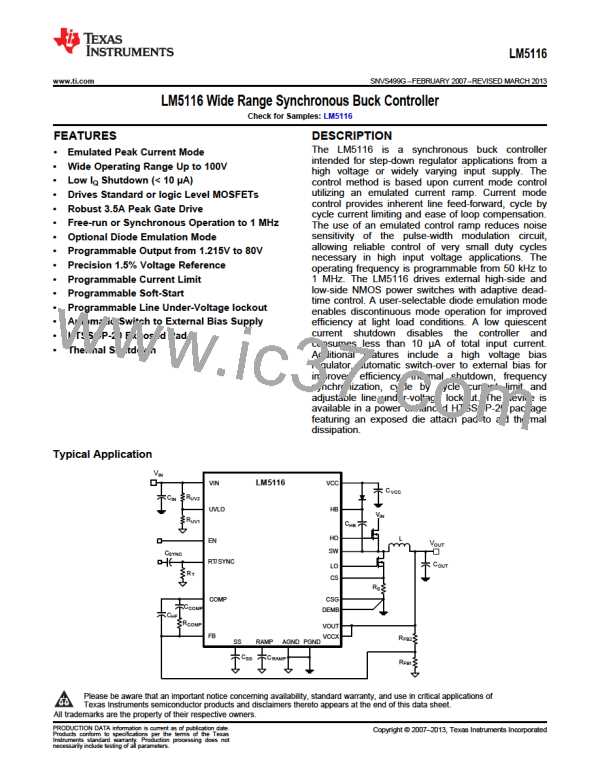LM5116
SNVS499G –FEBRUARY 2007–REVISED MARCH 2013
www.ti.com
VCC CAPACITOR
The primary purpose of the VCC capacitor (CVCC) is to supply the peak transient currents of the LO driver and
bootstrap diode (D1) as well as provide stability for the VCC regulator. These current peaks can be several
amperes. The recommended value of CVCC should be no smaller than 0.47 µF, and should be a good quality, low
ESR, ceramic capacitor located at the pins of the IC to minimize potentially damaging voltage transients caused
by trace inductance. A value of 1 µF was selected for this design.
BOOTSTRAP CAPACITOR
The bootstrap capacitor (CHB) between the HB and SW pins supplies the gate current to charge the high-side
MOSFET gate at each cycle’s turn-on as well as supplying the recovery charge for the bootstrap diode (D1).
These current peaks can be several amperes. The recommended value of the bootstrap capacitor is at least 0.1
µF, and should be a good quality, low ESR, ceramic capacitor located at the pins of the IC to minimize potentially
damaging voltage transients caused by trace inductance. The absolute minimum value for the bootstrap
capacitor is calculated as:
Qg
CHB
í
DVHB
where
•
•
Qg is the high-side MOSFET gate charge
ΔVHB is the tolerable voltage droop on CHB
(21)
CHB is typically less than 5% of VCC. A value of 1 µF was selected for this design.
SOFT START CAPACITOR
The capacitor at the SS pin (CSS) determines the soft-start time, which is the time for the reference voltage and
the output voltage to reach the final regulated value. The soft-start time tSS should be substantially longer than
the time required to charge COUT to VOUT at the maximum output current. To meet this requirement:
tSS > VOUT x COUT / (ICURRENT LIMIT – IOUT
)
(22)
The value of CSS for a given time is determined from:
tSS x 10 mA
CSS
=
1.215V
(23)
For this application, a value of 0.01 µF was chosen for a soft-start time of 1.2 ms.
OUTPUT VOLTAGE DIVIDER
RFB1 and RFB2 set the output voltage level, the ratio of these resistors is calculated from:
RFB2
RFB1
VOUT
- 1
=
1.215V
(24)
RFB1 is typically 1.21 kΩ for a divider current of 1 mA. The divider current can be reduced to 100 µA with
RFB1=12.1 kΩ. For the 5V output design example used here, RFB1 = 1.21 kΩ and RFB2 = 3.74 kΩ.
UVLO DIVIDER
A voltage divider and filter can be connected to the UVLO pin to set a minimum operating voltage VIN(MIN) for the
regulator. If this feature is required, the following procedure can be used to determine appropriate resistor values
for RUV2, RUV1 and CFT.
1. RUV2 must be large enough such that in the event of a current limit, the internal UVLO switch can pull UVLO
< 200 mV. This can be accomplished if: RUV2 > 500 x VIN(MAX)Where VIN(MAX) is the maximum input voltage
and RUV2 is in ohms.
2. With
an
appropriate
value
for
RUV2
,
RUV1
can
be
selected
using
the
following
RUV2
VIN(MIN) + (5 mA x RUV2) - 1.215
equation:R
Where VIN(MIN) is the desired shutdown voltage.
UV1 = 1.215 x
3. Capacitor CFT provides filtering for the divider and determines the off-time of the “hiccup” duty cycle during
current limit. When CFT is used in conjunction with the voltage divider, a diode across the top resistor should
22
Submit Documentation Feedback
Copyright © 2007–2013, Texas Instruments Incorporated
Product Folder Links: LM5116

 TI [ TEXAS INSTRUMENTS ]
TI [ TEXAS INSTRUMENTS ]